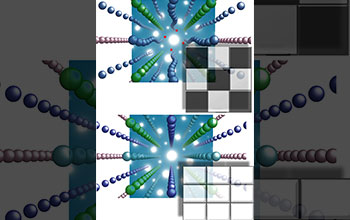Multimedia Gallery
Symmetry-breaking distortions in superconductors
(Top) Ripples extending down the chain of atoms breaks translational symmetry (like a checkerboard with black and white squares), which would cause extra spots in the diffraction pattern (shown as red dots in the underlying diffraction pattern).
(Bottom) Stretching along one direction breaks rotational symmetry but not translational symmetry (like a checkerboard with identical squares but stretched in one of the directions), causing no additional diffraction spots. The experiments proved these new superconductors have the second type of electron density distribution, called a nematic.
More about this image
In 2014, a team of scientists from the U.S. Department of Energy's (DOE) Brookhaven National Laboratory, Columbia Engineering, Columbia Physics and Kyoto University discovered an unusual form of electronic order in a new family of unconventional superconductors. The finding established an unexpected connection between this new group of titanium-oxypnictide superconductors and the more familiar cuprates and iron-pnictides, providing scientists with a whole new family of materials from which they can gain deeper insights into the mysteries of high-temperature superconductivity.
The research was supported in part by the National Science Foundation (grant OISE 09-68226).
Read more about this discovery in the NSF News From the Field story Unusual electronic state found in new class of unconventional superconductors. (Date image taken: December 2014; date originally posted to NSF Multimedia Gallery: Jan. 31, 2018)
Credit: Benjamin Frandsen, Columbia University
Images and other media in the National Science Foundation Multimedia Gallery are available for use in print and electronic material by NSF employees, members of the media, university staff, teachers and the general public. All media in the gallery are intended for personal, educational and nonprofit/non-commercial use only.
Images credited to the National Science Foundation, a federal agency, are in the public domain. The images were created by employees of the United States Government as part of their official duties or prepared by contractors as "works for hire" for NSF. You may freely use NSF-credited images and, at your discretion, credit NSF with a "Courtesy: National Science Foundation" notation.
Additional information about general usage can be found in Conditions.
Also Available:
Download the high-resolution JPG version of the image. (4.2 MB)
Use your mouse to right-click (Mac users may need to Ctrl-click) the link above and choose the option that will save the file or target to your computer.

